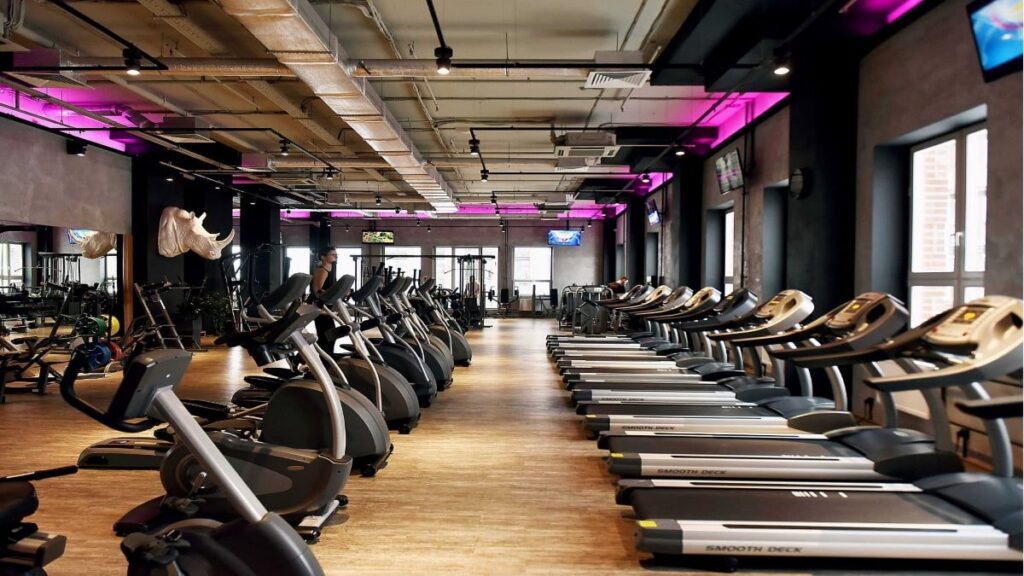What is a Battle Rope and how to use it in training?
Table of Contents
What is a Battle Rope
A battle rope is a long, heavy rope that is anchored to a point at one end and used for a variety of exercises that primarily work the upper body and core muscles. It’s typically made of durable materials like polyester or nylon and can range in length from 30 to 50 feet.
The user holds the free end of the rope and creates waves, slams, or circular motions with it, which creates resistance and engages the arms, shoulders, back, and core muscles.
Battle ropes are popular in fitness and sports training because they offer a challenging and effective workout that can improve strength, endurance, and cardiovascular fitness.
Battle Rope Training: Everything You Need to Know
When it comes to full-body workouts, battle ropes are one of the most efficient and effective tools out there. These thick, heavy ropes are perfect for building upper body strength and endurance, and they’re also great for improving your cardiovascular fitness.
Benefits of Battle Rope Training
- Full-body workout: Battle rope workouts engage your entire body, from your arms and shoulders to your core and legs.
- Cardiovascular fitness: Battle ropes can help you improve your cardiovascular fitness by increasing your heart rate and oxygen consumption.
- Strength and endurance: Regular battle rope training can help you build upper body strength and endurance, particularly in your arms, shoulders, and back.
- Low impact: Unlike some other forms of exercise, battle rope training is relatively low impact, making it a good option for people with joint pain or injuries.
How to Use Battle Ropes
Battle rope exercises can be broken down into two main categories: waves and slams. Here are some basic exercises to get you started:
Waves
- Alternating waves: Stand with your feet shoulder-width apart and hold one end of the rope in each hand. Keeping your core tight and your shoulders relaxed, alternate swinging each arm up and down to create a wave in the rope.
- Double waves: Similar to alternating waves, but this time swing both arms up and down simultaneously to create a larger wave in the rope.
- Outside circles: Hold the ropes in front of you with your arms extended and begin to move your arms in a circular motion, keeping the ropes moving in a continuous circle.
Slams
- Double slams: Stand with your feet shoulder-width apart and hold one end of the rope in each hand. Raise both arms above your head and then slam the ropes down onto the ground as hard as you can.
- Alternating slams: Similar to double slams, but this time alternate slamming each arm down onto the ground.
- Side-to-side slams: Stand with your feet shoulder-width apart and hold one end of the rope in each hand. Raise both arms above your head and then slam the ropes down onto the ground, moving your arms from side to side as you do so.
Tips for Effective Battle Rope Training
- Start slow: If you’re new to battle rope training, start with shorter workouts and fewer sets to avoid injury.
- Focus on form: Proper form is key to getting the most out of your battle rope workouts. Keep your core tight, your shoulders relaxed, and your movements controlled.
- Mix it up: Don’t be afraid to try new exercises and variations to keep your workouts challenging and interesting.
- Stay hydrated: Battle rope workouts can be intense, so make sure to drink plenty of water before, during, and after your workouts.
With these tips and exercises, you’ll be on your way to mastering battle rope training!
In what part of the training process can you use the Battle Rope?

The battle rope is a versatile piece of equipment that can be used in different phases of the training process. Here are some examples:
- Warm-up: You can use the battle rope as part of your dynamic warm-up routine. By performing a variety of movements with the rope, you can increase blood flow to the muscles, improve joint mobility, and activate the nervous system.
- Conditioning: The battle rope can also be used as a conditioning tool. By performing high-intensity interval training (HIIT) workouts with the rope, you can improve your cardiovascular fitness, build muscular endurance, and burn fat.
- Strength training: The battle rope can also be used to build strength. By performing exercises such as rope slams, waves, and circles, you can target the muscles in your arms, shoulders, back, and core.
- Recovery: Finally, the battle rope can also be used as part of your recovery routine. By performing slow, controlled movements with the rope, you can improve your range of motion, reduce muscle soreness, and promote relaxation.
Overall, the battle rope is a versatile tool that can be used in different phases of the training process. Whether you’re looking to warm up, condition, build strength, or recover, the rope can help you achieve your fitness goals.
What are the exercises with the Battle Rope, and how to do them correctly?

Battle ropes are a great tool for building strength, endurance, and cardiovascular fitness. There are many exercises that can be performed with battle ropes. Here are some examples of battle rope exercises and how to perform them correctly, based on information from various sources:
- The wave: This classic exercise is great for building strength and endurance. To do it, stand with your feet shoulder-width apart, holding one end of the rope in each hand. Raise your arms so that they are parallel to the ground, and then move them up and down in a wave-like motion. [1][2][3]
- Rope slams: This exercise targets your core, shoulders, and arms. Begin by standing with your feet hip-width apart and knees slightly bent, holding one end of the rope in each hand. Lift both hands overhead and perform a little jump small jump motion. Slam the ropes to the ground with as much force as you can, landing in a squat-like position. [4]
- Alternating waves: This exercise is similar to the wave, but you alternate between your left and right arm. Stand with your feet shoulder-width apart, holding one end of the rope in each hand. Raise your left arm so that it is parallel to the ground, then lower it as you raise your right arm. Continue alternating arms. [5]
- Outside circles: This exercise targets your shoulders, forearms, and grip strength. Stand with your feet shoulder-width apart, holding one end of the rope in each hand. Move your arms in circles, so that the rope moves in a circular motion. [6]
- In-Out Waves: This exercise targets your core, arms, chest, and shoulders. To do this, stand with your feet shoulder-width apart, holding one end of the rope in each hand. Create waves with the rope by alternating raising and lowering each arm. [7]
It is important to use proper form when performing these exercises to avoid injury and get the most benefit. It is recommended to start with lighter ropes and shorter sets, gradually increasing intensity and duration as you build strength and endurance.
Sources:
- Your Complete Guide to Battle Rope Workouts
- How to Get Started with Battle Rope Exercises
- 20 BEST BATTLING ROPE EXERCISES & WORKOUTS
- HERE’S WHY BATTLE ROPES DESERVE A PLACE IN YOUR WORKOUT PROGRAM
- A Beginner’s Guide to Battle Ropes
- 20 BEST BATTLING ROPE EXERCISES & WORKOUTS
- How to Get Started with Battle Rope Exercises
Common Mistakes

There are some common mistakes that people make when using the Battle Rope. Here are a few to watch out for:
- Gripping the ropes too tightly: Gripping the ropes too tightly can cause unnecessary strain on your hands, arms, and shoulders. Instead, focus on keeping a loose grip and using your core and legs to generate the movement.
- Using only your arms: Many people make the mistake of thinking that battle ropes are an arm workout, but they actually require full-body engagement. Make sure to involve your legs, core, and back muscles as well.
- Not using proper form: It’s important to maintain proper form when using battle ropes to avoid injury and ensure that you’re getting the most out of your workout. Keep your feet shoulder-width apart, maintain a slight bend in your knees, and engage your core to keep your back straight.
- Going too fast: While it may be tempting to try and go as fast as possible, it’s important to maintain control and focus on form. Start with a slower pace and gradually increase speed as you become more comfortable with the movement.
- Neglecting to stretch: Using battle ropes can be intense on your muscles, so it’s important to properly stretch before and after your workout to prevent injury and aid in recovery.
By avoiding these common mistakes, you can get the most out of your battle rope workout and achieve your fitness goals.
Final Words
The Benefits of Using a Battle Rope for Muscle Recovery
As someone who has personally used the Battle Rope for muscle recovery, I can attest to its beneficial effects on clogged muscles, injured tendons, and tension in the cervical vertebrae. While it may seem like a simple fitness tool, the Battle Rope has the ability to disperse stagnation in the muscles and promote overall muscle recovery.
Dispersion of Stagnation in the Muscles
The Battle Rope is a great way to disperse stagnation in the muscles. Stagnation occurs when there is a buildup of lactic acid in the muscles, which can lead to muscle soreness and stiffness. By using the Battle Rope, you are able to activate and engage multiple muscle groups at once, promoting blood flow and oxygenation to the muscles. This helps to reduce the buildup of lactic acid, leading to quicker recovery and less muscle soreness.
Tension Relief
Tension in the cervical vertebrae is a common issue for many people. This tension can lead to headaches, neck pain, and even migraines. By using the Battle Rope, you can help relieve tension in the cervical vertebrae. By engaging the muscles in the upper body, you are able to release tension and promote relaxation in the neck and shoulders.
In conclusion, the Battle Rope is a great tool for promoting muscle recovery and preventing injuries. By engaging multiple muscle groups at once, the Battle Rope helps to disperse stagnation in the muscles, leading to quicker recovery times and less muscle soreness. It also helps to strengthen the muscles, which can help prevent injuries from occurring in the first place. Lastly, the Battle Rope can help relieve tension in the cervical vertebrae, leading to a more relaxed and comfortable body.
Read Also:
- Circuit training is one of the best workout options in the gym
- What are the simulators in gyms?
- Best Cardio warm-up for the Gym
- Benefits of Nordic walking
- How to choose the Right Weight Bar, Benefits, and Contraindications




